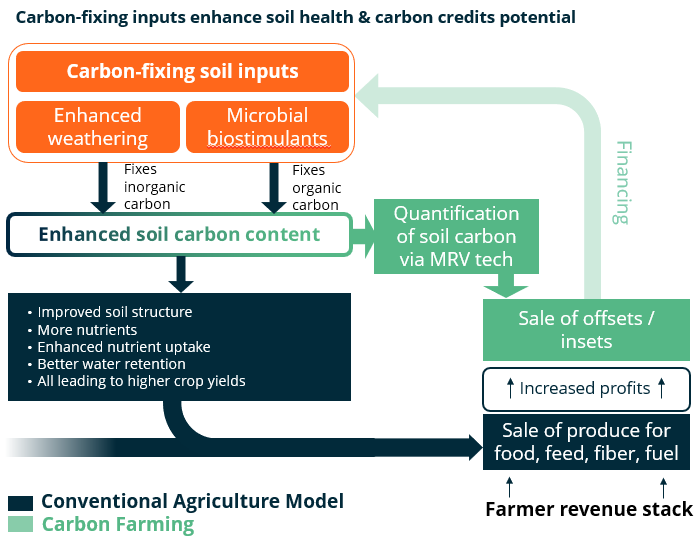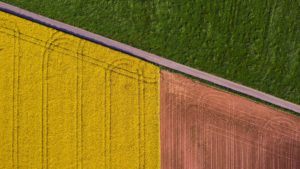Reversing Agriculture’s Emissions with Carbon-Fixing Soil Inputs
Agricultural soils emit millions of tons of carbon each year. These microbes and minerals help to put that carbon back in the ground.
The world needs to produce more food than ever before in order to feed a rapidly growing global population. This means getting more yield from the crops we cultivate and the land we grow them on.
Conventionally, this has been achieved through a combination of intensive agricultural practices – such as deforestation and mechanized tillage – and the application of chemicals, such as synthetic fertilizers that add crucial nutrients to the soil, and pesticides that protect plants from hazards as they grow.
The problem is that the manufacture and transportation of these chemicals cause greenhouse gas emissions – as do the chemicals themselves when they are over-applied on farmers’ fields, while intensive farming practices like deep tillage and removal of crop residues release carbon from the soil into the atmosphere.
Carbon and Soil Health
This last point is important because carbon has a critical role to play in soil health. Soils with suboptimal carbon content have a weaker physical structure, meaning they are less able to retain water and nutrients, and are at higher risk of erosion – leading to less fertile land.
As a result, farmers apply ever-increasing amounts of chemicals, and engage in increasingly intensive practices, in an effort to boost productivity.
Many farmers are looking to break this vicious cycle by turning to regenerative agriculture – a set of practices and principles that puts an emphasis on circularity, minimizing soil disturbance, and forgoing the use of synthetic chemicals. These techniques can, among other things, boost soil carbon stocks over time, realizing the benefits of enhanced water and nutrient retention – as explored in our recent Carbon Farming Sector Insight.
Another approach being pursued by innovators is the development of biological alternatives that are less toxic and more sustainable than conventional agrochemical products.

Miraculous Microbes and Minerals
Falling somewhere along the spectrum between these two strategies is the emerging category of carbon-fixing soil inputs. These include biological and mineral products that can be added to the soil to enhance its carbon content and improve soil health and productivity.
- Some carbon-fixing soil inputs rely on microbes to enhance natural processes which draw down atmospheric carbon into the soil (e.g., Loam Bio).
- Others directly add carbon to soils via a process called enhanced weathering, in which carbon-rich rocks or minerals are pulverized before being spread on to field surfaces (e.g., Lithos Carbon).
These new products have been made possible through an improved understanding of the soil microbiome, identification of beneficial bacteria and fungi, and advances in synthetic biology and biomanufacturing that are increasingly being leveraged by innovators:
- Microbial inputs rely on interactions between plants and naturally occurring microbes to fix organic carbon in soils:
- They enhance the natural carbon drawdown process by inoculating seeds with beneficial microbes, including plant growth-promoting rhizobacteria, mycorrhizal fungi, and endophytic fungi which colonize plant root systems and the surrounding soil (the ‘rhizosphere’).
- These generally act by enhancing the export of carbon from the plant and into the soil, e.g., Loam Bio uses melanized endophytic fungi which feed on carbon-rich sugars exuded from plant roots, converting these into long-lasting carbon ‘micro-aggregates’ in soil around the root zone.
- It’s worth noting that several of these microbial products have other benefits for soil health and crop growth (in some cases, their carbon-fixing ability has been marketed as secondary) – e.g., Andes’ nitrogen-fixing microbes that reduce reliance on synthetic fertilizer.
- They enhance the natural carbon drawdown process by inoculating seeds with beneficial microbes, including plant growth-promoting rhizobacteria, mycorrhizal fungi, and endophytic fungi which colonize plant root systems and the surrounding soil (the ‘rhizosphere’).
- Enhanced weathering solutions directly add inorganic carbon to soil:
- The enhanced weathering process seeks to accelerate the natural breakdown of rock and mineral into soil inorganic carbon by crushing these carbon-rich materials, thereby increasing the surface area, and applying to land surfaces.
- Eion uses olivine, Lithos Carbon uses basalt, while Silicate is experimenting with upcycled
- Operationally, these products can replace or complement the traditional agricultural practice of spreading lime to affect soil acidity and add nutrients such as calcium and magnesium.
- The enhanced weathering process seeks to accelerate the natural breakdown of rock and mineral into soil inorganic carbon by crushing these carbon-rich materials, thereby increasing the surface area, and applying to land surfaces.
- Other products that can be added to soil to enhance carbon content include compost, manure, lime, sands and silicates, ash, and biochar.
Adding Carbon Payments into the Mix
Notably, innovators in both the microbial and the enhanced weathering categories are layering carbon credit initiatives on top of their core input products in an effort to help farmers and agribusinesses participate in carbon markets and to provide them with economic incentives to use their inputs (e.g., Loam Bio’s SecondCrop platform).
These additional income streams from carbon farming can smooth out bumpy revenue from conventional agriculture, which is increasingly unpredictable due to climate change – and they can also finance farmers’ adoption of more sustainable technologies.



